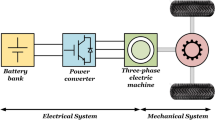Abstract
Power managements of a UAV’s hybrid electric propulsion systems are described. Three electric propulsion systems with different power sources, i.e. solar cells, fuel cells, and batteries are considered. Each power source is modeled in Matlab/Simulink and integrated into the power system. For fuel cells and batteries, the simulation process is verified via comparison between the simulation results and available flight test results of UAVs. Two types of power control logics are investigated: passive and active. The passive power management simulation shows that the behavior of each power source and its integrated system is adequate for the overall flight envelope. In addition, the active power management simulation demonstrates that active power management yields more efficient power distribution and better system safety than passive power management does. Also, a power simulation of a hybrid electric power system allows for estimation of the output behavior of the power source. Therefore, it can be a valuable tool for development of a power control logic that ensures efficient power distribution.
Similar content being viewed by others
References
T. H. Bradley, B. Moffitt, D. Mavris and D. E. Parekh, Development and experimental characterization of a fuel cell powered aircraft, Journal of Power Sources, 171(2) (2007) 793–801.
A. Crumm, Solid oxide fuel cell systems, Proceedings of the Fuel Cell Seminar, Honolulu, HI (2006).
W. Gao, S. Neema, J. Gray, J. Picone, S. Porandla, S. Musunuri and J. Mathews, Hybrid powertrain design using a domain-specific modeling environment, Proceedings of the IEEE Vehicle Power Propulsion Conference, Chicago, USA (2005) 6–12.
K. B. Wipke, M. R. Cuddy and S. D. Burch, ADVISOR 2.1: A user-friendly advanced powertrain simulation using a combined backward/forward approach, IEEE Transactions on Vehicular Technology, 48(6) (1999) 1751–1761.
A. D. Hansen, P. Sørensen, L. H. Hansen and H. Bindner, Models for have stand-alone statement system, National Risø Laboratory, Roskilde (2000).
P. Buasri and Z. M. Salameh, An electrical circuit model for a proton exchange membrane fuel cell, IEEE:1-4244-0493-2 (2006).
D. J. Lee and L. Wang, Dynamic and steady-state performance of PEM fuel cells under various loading conditions, IEEE: 1-4244-1298-6 (2007).
X. Qingshan, W. Nianchu, K. Ichiyanagi and K. Yukita, PEM fuel cell modeling and parameter influences of performance evaluation, DRPT2008.
O. Tremblay and L. A. Dessaint, Experimental validation of a battery dynamic model for EV applications, World Electric Vehicle Journal, EVS24, Vol. 3, Stavanger, Norway (2009).
P. Thounthong and P. Sethakul, Analysis of fuel starvation phenomenon of a PEM fuel cell, IEEE 4th Power Conversion Conference, Nagoya, Japan (2007).
D. Peftitsis, G. Adamidis and A. Balouktsis, An investigation of new control method for MPPT in PV array using DCDC buck-boost converter, Proceeding 4th Annual Allerton Conference, Circuits and Systems theory, New York, USA (1994).
M. Ehsani, Y. Gau and A. Emadi, Parallel hybrid electric drive train design, modern electric, Hybrid Electric, and Fuel Cell Vehicles fundamentals, theory, and design, Second Ed.
Author information
Authors and Affiliations
Corresponding author
Additional information
Recommended by Associate Editor Tong Seop Kim
Bohwa Lee received her M.S. in Mechanical Engineering from Korea Advanced Institute Science and Technology, Daejeon, Korea in 2006. In 2005, she joined the Aeropropulsion System Team, Korea Aerospace Research Institute, Daejeon, Korea.
Poomin Park received his Ph.D in Mechanical Engineering from Korea Advanced Institute Science and Technology, Daejeon, Korea in 2001. In 2003, he joined the Aeropropulsion System Team, Korea Aerospace Research Institute, Daejeon, Korea.
Chuntaek Kim received his Ph.D in Aerospace Engineering from Korea Advanced Institute Science and Technology, Daejeon, Korea in 2007. In 1995, he joined the Aeropropulsion System Team, Korea Aerospace Research Institute, Daejeon, Korea.
Rights and permissions
About this article
Cite this article
Lee, B., Park, P., Kim, C. et al. Power managements of a hybrid electric propulsion system for UAVs. J Mech Sci Technol 26, 2291–2299 (2012). https://doi.org/10.1007/s12206-012-0601-6
Received:
Revised:
Accepted:
Published:
Issue Date:
DOI: https://doi.org/10.1007/s12206-012-0601-6




